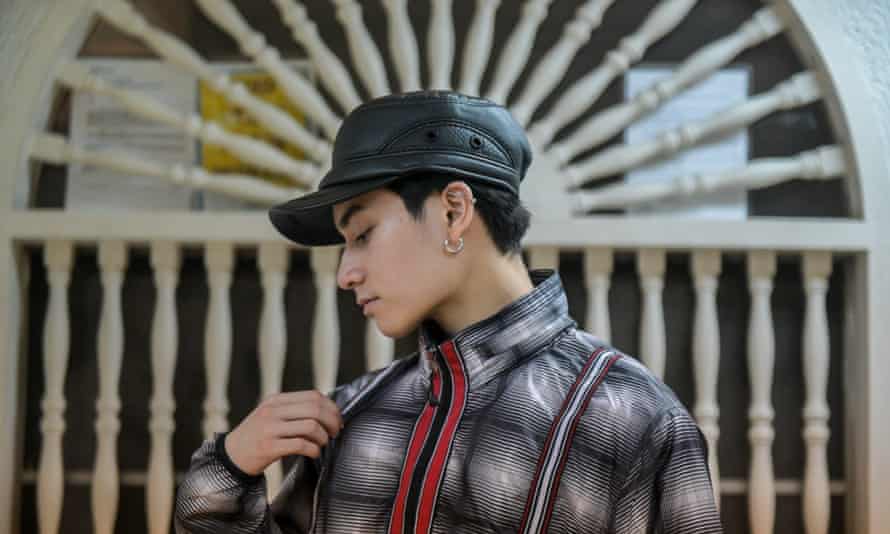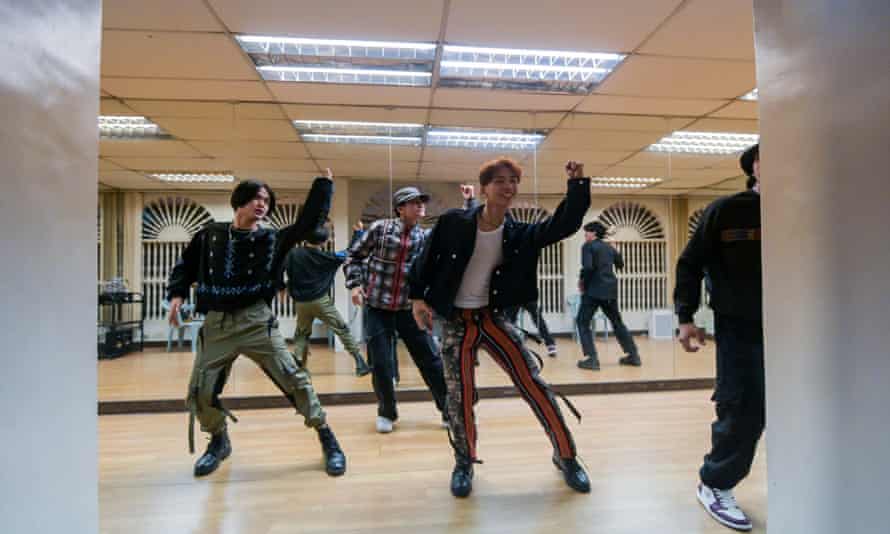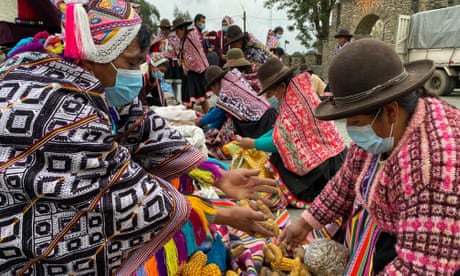Alamat are aiming to bring their music to the world – by singing in their local languages

Filipino boy group Alamat at Viva Studios in Quezon City.
Photograph: Alecs Ongcal
WITH TRADITIONAL FILIPINO MARTIAL ARTS FIGHTING STICKS
Rebecca Ratcliffe and Lorna Bayani
Sun 29 May 2022
Vocal coach Zebedee Zuñiga twists his hand in the air, and the melody of a tender, haunting lullaby, Ili Ili Tulog Anay, begins. “Little one, little one, sleep now/ Your mother is not here / She went to buy some bread,” sing the six members of Alamat, sitting in a circle. Then hip-hop beats kick in; the traditional Philippine lullaby, known as oyayi, is merged with more contemporary sounds.
It’s a Monday afternoon at Viva records’ studios, and Alamat, one of the label’s rising acts, are rehearsing their next single. They’re part of a new wave of bands, often referred to as P-pop, flourishing in the Philippines.
Over past decades in Japan and South Korea, J-pop and later K-pop, emerged as huge cultural exports. K-pop is now a multibillion-dollar industry; last year Korean band BTS were the bestselling act globally, for the second year running. In the Philippines, record labels are hoping the country’s music scene could get a share of that global success.
P-pop bands are influenced by K-pop, but there is also a growing willingness to experiment with the Philippines’ own diverse languages and culture, which are sidelined by the country’s mainstream pop culture.
Such music has developed loyal fanbases at home, and is beginning to find success abroad too. Alamat’s debut single, Kbye, debuted at No 2 on Billboard’s Next Big Sound chart, while fellow P-pop band SB19 were nominated for Billboard’s top social artist category last year.

Rebecca Ratcliffe and Lorna Bayani
Sun 29 May 2022
Vocal coach Zebedee Zuñiga twists his hand in the air, and the melody of a tender, haunting lullaby, Ili Ili Tulog Anay, begins. “Little one, little one, sleep now/ Your mother is not here / She went to buy some bread,” sing the six members of Alamat, sitting in a circle. Then hip-hop beats kick in; the traditional Philippine lullaby, known as oyayi, is merged with more contemporary sounds.
It’s a Monday afternoon at Viva records’ studios, and Alamat, one of the label’s rising acts, are rehearsing their next single. They’re part of a new wave of bands, often referred to as P-pop, flourishing in the Philippines.
Over past decades in Japan and South Korea, J-pop and later K-pop, emerged as huge cultural exports. K-pop is now a multibillion-dollar industry; last year Korean band BTS were the bestselling act globally, for the second year running. In the Philippines, record labels are hoping the country’s music scene could get a share of that global success.
P-pop bands are influenced by K-pop, but there is also a growing willingness to experiment with the Philippines’ own diverse languages and culture, which are sidelined by the country’s mainstream pop culture.
Such music has developed loyal fanbases at home, and is beginning to find success abroad too. Alamat’s debut single, Kbye, debuted at No 2 on Billboard’s Next Big Sound chart, while fellow P-pop band SB19 were nominated for Billboard’s top social artist category last year.

A member of Alamat. Each is from a different part of the country and sings in his own ethnic language. Photograph: Alecs Ongcal/The Observer
Korean and Filipino entertainment companies are investing in the trend in the hope of finding the next global stars, says Ian Urrutia, music writer and founder of Nyou Philippines, a Manila-based music and entertainment PR agency. “In terms of production and music-making process, a lot of entertainment companies have hired top K-pop producers to kickstart their talents,” he said.
Advertisement
Jason Paul Laxamana, Alamat’s creative director, says he hopes to adopt the coaching and discipline that has shaped Korea’s pop industry – “and the fact that K-pop was able to dominate the world without having to drop Korean”.
For Alamat, language is especially important. Each member of the group comes from a different part of the country and sings in their own ethnic language. As well as Tagalog, the Philippines’ main language – these include Ilocano, Kapampangan, Bicolano, Waray-Waray, Bisaya and Sambal.
It’s highly unusual for mainstream pop. “There’s a notion that one language is superior to others,” says band member Taneo. “It’s part of our mission to have especially the younger generations be proud of their own roots.”
Laxamana remembers being a student and wondering why he never heard songs in his ethnic language, Kapampangan, played on the radio. Little has changed since then. “All I heard was songs in English, Tagalog, and eventually Korean,” he says. Shopping malls are reluctant to play songs in other Philippine languages, believing that they are less glamorous. So too are some radio stations, he adds.

Korean and Filipino entertainment companies are investing in the trend in the hope of finding the next global stars, says Ian Urrutia, music writer and founder of Nyou Philippines, a Manila-based music and entertainment PR agency. “In terms of production and music-making process, a lot of entertainment companies have hired top K-pop producers to kickstart their talents,” he said.
Advertisement
Jason Paul Laxamana, Alamat’s creative director, says he hopes to adopt the coaching and discipline that has shaped Korea’s pop industry – “and the fact that K-pop was able to dominate the world without having to drop Korean”.
For Alamat, language is especially important. Each member of the group comes from a different part of the country and sings in their own ethnic language. As well as Tagalog, the Philippines’ main language – these include Ilocano, Kapampangan, Bicolano, Waray-Waray, Bisaya and Sambal.
It’s highly unusual for mainstream pop. “There’s a notion that one language is superior to others,” says band member Taneo. “It’s part of our mission to have especially the younger generations be proud of their own roots.”
Laxamana remembers being a student and wondering why he never heard songs in his ethnic language, Kapampangan, played on the radio. Little has changed since then. “All I heard was songs in English, Tagalog, and eventually Korean,” he says. Shopping malls are reluctant to play songs in other Philippine languages, believing that they are less glamorous. So too are some radio stations, he adds.

Alamat rehearse a dance routine.
Photograph: Alecs Ongcal/The Observer
Philippine languages – there are as many as 182 – are often wrongly downgraded as dialects, says Dr Ruanni Tupas of University College London, who has researched the role of Philippine languages in P-pop. “This is how colonial education was formed in favour of, for example, the English language. English was taught as a language but the rest of the Philippine languages as dialects.”
Speaking Philippine languages is associated “with coming from the provinces, with the lower class. It’s associated with being uneducated,” Tupas adds. “It has always been attached to Filipinos losing their own confidence in themselves.” Bands such as Alamat and SB19 have helped change this perception, he says.
Much of Alamat’s performance is rooted in Philippine culture. Their outfits blend modern streetwear with references to traditions from across the country – from Tayum, the indigo clothes worn by Kapampangan men, to the tattoos of Kalinga warriors and the colourful sails of the Vinta (small boats) of Zamboanga.
Choreography and melodies also reflect the country’s musical heritage – from Kundiman, a Philippine serenade, to folk music.

Indigenous languages project urges Cop26 leaders to rethink ties to the land
Ili Ili Tulog Anay is a Hiligaynon lullaby, traditionally sung by a nanny or sibling to a baby while their mother is away. Alamat’s version uses the song to explore the emotions of children whose parents work for long stretches overseas – 1.77 million Filipinos did so in 2020.
“I think it will resonate with a lot of Filipinos,” says Laxamana, whose father has worked abroad since he was a child. “The big brother tries to comfort the siblings, telling them that our parents will be home some day. But right now, you know, we are poor. So we need to work, we need to sacrifice,” he says of the lyrics. Other songs touch on social issues such as the legacy of colonialism and racism – with music videos referencing the oppression of the first Filipino Americans, and continued colourism with Philippine society.
Alamat’s supporters believe the group’s distinctive style could help them to stand out internationally. But the band members say that, for now, their focus is on growing, and shaping attitudes at home. “We want fellow Filipinos to dance and sing to our music and to make them proud of our own cultural diversity and our multilingualism,” says band member Jao.
“We want them to hug themselves.”
Philippine languages – there are as many as 182 – are often wrongly downgraded as dialects, says Dr Ruanni Tupas of University College London, who has researched the role of Philippine languages in P-pop. “This is how colonial education was formed in favour of, for example, the English language. English was taught as a language but the rest of the Philippine languages as dialects.”
Speaking Philippine languages is associated “with coming from the provinces, with the lower class. It’s associated with being uneducated,” Tupas adds. “It has always been attached to Filipinos losing their own confidence in themselves.” Bands such as Alamat and SB19 have helped change this perception, he says.
Much of Alamat’s performance is rooted in Philippine culture. Their outfits blend modern streetwear with references to traditions from across the country – from Tayum, the indigo clothes worn by Kapampangan men, to the tattoos of Kalinga warriors and the colourful sails of the Vinta (small boats) of Zamboanga.
Choreography and melodies also reflect the country’s musical heritage – from Kundiman, a Philippine serenade, to folk music.

Indigenous languages project urges Cop26 leaders to rethink ties to the land
Ili Ili Tulog Anay is a Hiligaynon lullaby, traditionally sung by a nanny or sibling to a baby while their mother is away. Alamat’s version uses the song to explore the emotions of children whose parents work for long stretches overseas – 1.77 million Filipinos did so in 2020.
“I think it will resonate with a lot of Filipinos,” says Laxamana, whose father has worked abroad since he was a child. “The big brother tries to comfort the siblings, telling them that our parents will be home some day. But right now, you know, we are poor. So we need to work, we need to sacrifice,” he says of the lyrics. Other songs touch on social issues such as the legacy of colonialism and racism – with music videos referencing the oppression of the first Filipino Americans, and continued colourism with Philippine society.
Alamat’s supporters believe the group’s distinctive style could help them to stand out internationally. But the band members say that, for now, their focus is on growing, and shaping attitudes at home. “We want fellow Filipinos to dance and sing to our music and to make them proud of our own cultural diversity and our multilingualism,” says band member Jao.
“We want them to hug themselves.”
No comments:
Post a Comment